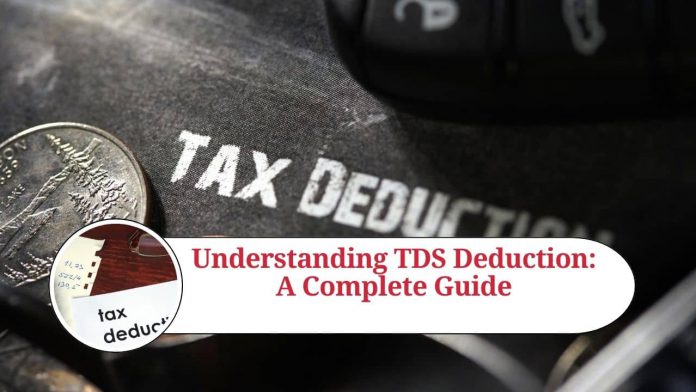Introduction
TDS or Tax Deducted at Source is a type of tax that is deducted at the source of income, i.e., when the payment is made by the payer to the payee. It is a system of collecting taxes in advance to ensure that taxpayers pay their taxes regularly. TDS is applicable on various types of income, including salary, interest, commission, rent, professional fees, etc.
Here is a complete guide to understanding TDS deduction, including its purpose, calculation, and provisions.
Purpose of TDS Deduction
The primary purpose of TDS deduction is to ensure that taxpayers pay their taxes regularly, rather than waiting until the end of the financial year to pay them. TDS deduction ensures that taxes are collected in advance and helps to reduce tax evasion. It also helps in the smooth functioning of the government by providing a regular inflow of taxes.
Calculation of TDS Deduction
TDS is calculated on the basis of the total amount paid to the payee. The rate of TDS deduction varies depending on the type of payment and the category of the payee. The payer is required to deduct TDS at the applicable rate and deposit it with the government within the specified time.
Provisions for TDS Deduction
There are various provisions for TDS deduction under the Income Tax Act, 1961. Some of the significant provisions are:
- TDS on Salary: Employers are required to deduct TDS from the salary paid to their employees based on their income tax slab rates.
- TDS on Interest: Banks and other financial institutions are required to deduct TDS on the interest paid on deposits, loans, and other investments.
- TDS on Rent: Individuals and businesses who pay rent exceeding Rs. 50,000 per month are required to deduct TDS at the rate of 2% on the total rent paid.
- TDS on Professional Fees: Individuals and businesses who pay professional fees exceeding Rs. 30,000 in a financial year are required to deduct TDS at the rate of 10% on the total fees paid.
- TDS on Sale of Property: TDS is applicable on the sale of property at the rate of 1% on the total sale price.
- TDS on Commission: Individuals and businesses who pay commission exceeding Rs. 15,000 in a financial year are required to deduct TDS at the rate of 10% on the total commission paid.
- TDS on Royalties and Fees for Technical Services: TDS is applicable on royalties and fees for technical services paid to non-residents at the rate of 10% on the total amount paid.
Steps for TDS Deduction
TDS deduction involves the following steps:
- Calculation of Total Payment: The payer needs to calculate the total payment made to the payee, including the amount subject to TDS.
- Determination of Applicable TDS Rate: The payer needs to determine the applicable TDS rate based on the type of payment and the category of the payee. The rate can be found in the TDS rate chart published by the Income Tax Department.
- Deduction of TDS: The payer needs to deduct the TDS at the applicable rate from the total payment made to the payee.
- Deposit of TDS: The payer needs to deposit the TDS amount with the government within the specified time. The due date for depositing TDS is the 7th of the following month for non-government deductors and the 30th of the following month for government deductors.
- Filing of TDS Return: The payer needs to file a TDS return with the government, providing details of the TDS amount deducted and deposited with the government.
Consequences of Non-Compliance
Non-compliance with TDS provisions can lead to various consequences, including:
- Interest and Penalty: The payer may be liable to pay interest and penalty for non-deduction or non-deposit of TDS.
- Prosecution: In severe cases, non-compliance with TDS provisions may lead to prosecution under the Income Tax Act, 1961.
- Disallowance of Expenditure: If TDS is not deducted or deposited, the expenditure made by the payer may be disallowed while calculating the taxable income.
TDS Deduction and TDS Certificate
Once the TDS is deducted, the payer needs to issue a TDS certificate to the payee as proof of TDS deduction. The TDS certificate contains details such as the amount of TDS deducted, the rate of TDS, the amount paid to the payee, and the TDS deposit date.
The payer is required to issue a TDS certificate to the payee within the specified time, which is:
- Form 16 for TDS on Salary – By 15th June of the following financial year
- Form 16A for TDS on payments other than Salary – Within 15 days of filing the TDS return
- Form 16B for TDS on Sale of Property – Within 15 days of filing the TDS return
- Form 16C for TDS on Rent – Within 15 days of filing the TDS return
The payee can use the TDS certificate while filing their income tax return to claim credit for the TDS deducted. It is essential to verify the details mentioned in the TDS certificate to ensure that the TDS deducted is correctly credited to the payee’s account.
Conclusion
TDS deduction is a crucial system for collecting taxes in advance and ensuring regular payment of taxes. It is applicable on various types of income, and the rate of TDS deduction varies depending on the type of payment and the category of the payee. Understanding the provisions of TDS deduction is essential for both the payer and the payee to ensure compliance with the Income Tax Act, 1961.
Read more useful content:
- How to Save Tax on Salary
- Guide to Understanding Direct Taxes in India
- Filing Income Tax Returns
- GST E-invoice
Frequently Asked Questions (FAQ’s)
Q1.) What is TDS?
TDS stands for Tax Deducted at Source. It is a system for collecting taxes in advance by deducting a certain percentage of the payment made to a payee.
Q2.) Who is liable to deduct TDS?
The payer, who is making the payment, is liable to deduct TDS.
Q3.) What are the payments subject to TDS?
Payments such as salary, rent, commission, professional fees, interest, and dividends are subject to TDS.
Q4.) What is the rate of TDS?
The rate of TDS depends on the type of payment and the category of the payee. The applicable TDS rate can be found in the TDS rate chart published by the Income Tax Department.
Q5.) What is the TDS threshold limit?
The TDS threshold limit is the minimum payment amount above which TDS needs to be deducted. The threshold limit varies based on the type of payment and the category of the payee.
Q6.) Can a payee claim a refund of TDS?
Yes, the payee can claim a refund of the excess TDS deducted by filing an income tax return.
Q7.) What is the penalty for non-deduction of TDS?
The payer may be liable to pay a penalty equal to the amount of TDS not deducted, along with interest.
Q8.) What is the penalty for non-deposit of TDS?
The payer may be liable to pay a penalty of 1% per month or part of a month, along with interest, for the period of delay in depositing TDS.
Q9.) Can TDS be paid online?
Yes, TDS can be paid online through the government’s e-payment portal.
Q10.) What is the due date for filing TDS return?
The due date for filing TDS return is the 31st of May for the financial year ending in March.




















